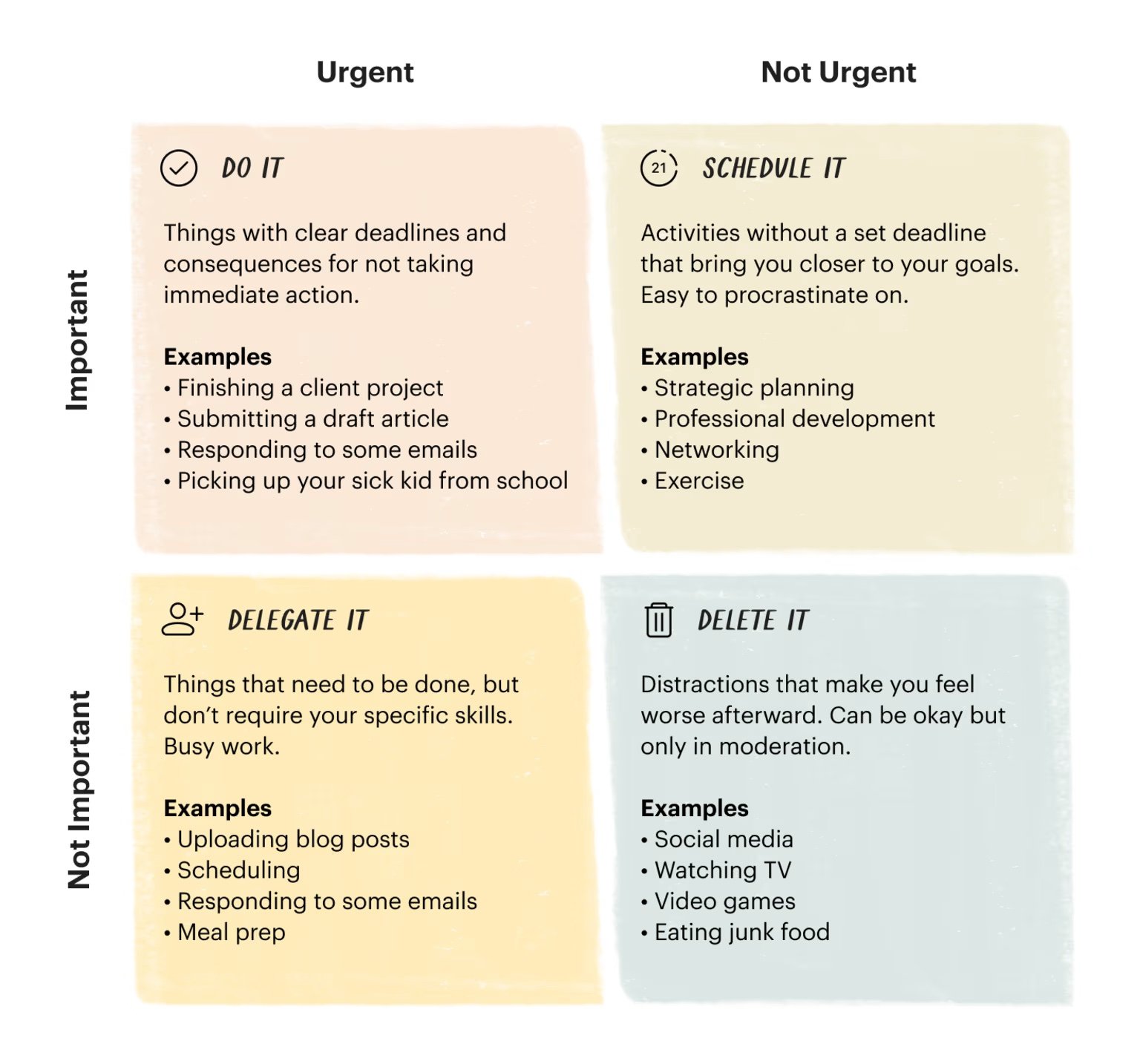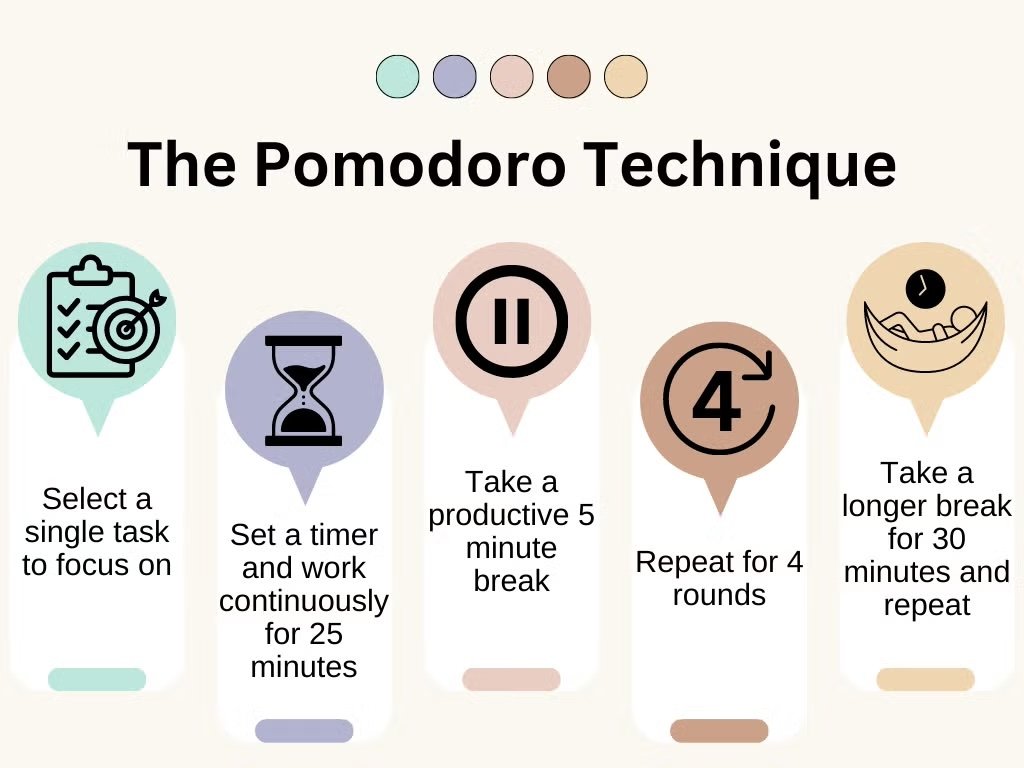The Art of Scheduling: Time Management Strategies
If you’ve ever felt like there aren’t enough hours in the day or found yourself endlessly scrolling on your phone while important tasks pile up, you’re not alone. Many of us experience these moments, and it can feel frustrating or bring a sense of guilt when time slips away, leaving little space for the things that matter.
Understanding Time Management
Time management is about prioritizing and organizing tasks to make the best use of each day. Many studies show that when practiced intentionally, it helps us accomplish more, reduces stress, and improves well-being (Weiderman, 2023). Effective time management can boost self-esteem and help create a positive cycle of productivity and satisfaction. Rather than just tracking hours, it’s about focusing time and energy on what’s important. The process starts with raising awareness of your own tendencies and experimenting with what works best for you.
Common Barriers to Effective Time Management
Many factors can make time management feel like a challenge, such as these common barriers:
Stress and Anxiety: Mental health concerns can drain focus, making it challenging to concentrate and organize tasks effectively.
Motivation: When motivation dips, it’s tempting to focus on distractions rather than essential tasks.
Procrastination: Delaying tasks can seem harmless at first, but it can build up into feelings of anxiety and being overwhelmed.
Distractions: Social media and other digital activities can easily steal hours of time without realizing it.
Poor Planning: Without a clear plan, it’s difficult to prioritize, leading to scattered focus and inefficiency.
Through awareness and a willingness to try strategies for time management, these barriers can be minimized or overcome.
Practical Strategies for Time Management
Set Priorities and Define Daily Goals: Start each day by identifying one key task that’s most meaningful or impactful. This can reduce anxiety and increase focus. Tools like the Eisenhower Matrix can help you prioritize by categorizing tasks as urgent/important, important/not urgent, and so on, allowing you to focus on what truly matters (Eisenhower Matrix).
Use Structured Time Techniques: The Pomodoro Technique involves working in focused 25-minute intervals with short breaks. After four cycles, take a longer break to recharge. This technique encourages sustained concentration and prevents burnout (more details at The Pomodoro Technique).
Set Clear, Achievable Goals: Develop SMART Goals (Specific, Measurable, Achievable, Relevant, and Time-bound) to clarify objectives and provide actionable steps. For instance, instead of “do better at work,” aim for “spend 30 minutes each morning on focused planning.”
Limit Distractions and Avoid Multitasking: Dedicate blocks of time for deep work by altering your environment to reduce interruptions. Avoid multitasking, as it can lead to errors and decreased productivity (Wiederman, 2023).
Reflect and Adjust Regularly: Every few weeks, assess which strategies work best and be willing to adjust as needed. Time management isn’t one-size-fits-all, so flexibility is key.
Managing Time with ADHD
For people with ADHD, time management can feel especially challenging. ADHD can make it difficult to focus, transition, or manage time effectively, so additional strategies may be helpful:
External Alert Systems: Timers can help create a sense of urgency and interrupt hyperfocus/flow to transition to the next task. For example, if you wish to work for 30 minutes, set a timer for 25 minutes and another for 30 minutes. The first timer tells you to finish up, and the second indicates it's time to get up and leave (Orlov, 2019).
Take Transitions into Account: To manage your time effectively, consider the transitions between tasks. Time everyday activities like getting out of bed or commuting, rather than guessing their duration. Once you know how long each task takes, add an extra 10-20% to your estimates for a buffer (Orlov, 2019).
Visual Schedules and Color Coding: A color-coded schedule or calendar can help prioritize tasks visually, making it easier to remember and organize responsibilities.
Break Tasks into Smaller Steps: A large task can feel overwhelming, so breaking it into smaller, achievable steps makes it more manageable.
It’s a Process
Managing time is a process, and there is no one-size-fits-all approach. It takes time to develop habits that work for you, and they may shift over time. Whether you’re managing a busy schedule, overcoming barriers, or dealing with ADHD, remember that time management is about creating a life with more balance and less stress. As you experiment with these strategies, give yourself grace and self-compassion; it’s okay if it takes a while to find what’s effective.
To Learn More
For additional support or to learn more about how counselling can help with time management and goal setting, please contact Panorama Wellness Group. To learn about me and the services I provide as a Registered Clinical Counsellor, please visit my bio here.
References
Orlov, K. (2019). 6 tips for better managing time for adults with ADHD. Psychology Today. https://www.psychologytoday.com/intl/blog/may-i-have-your-attention/201907/6-tips-better-managing-time-adults-adhd
Wiederman, M. (2023). The psychology of time management and 5 strategies. Psychology Today. https://www.psychologytoday.com/us/blog/mindful-professional-development/202309/the-psychology-of-time-management-and-5-strategies


